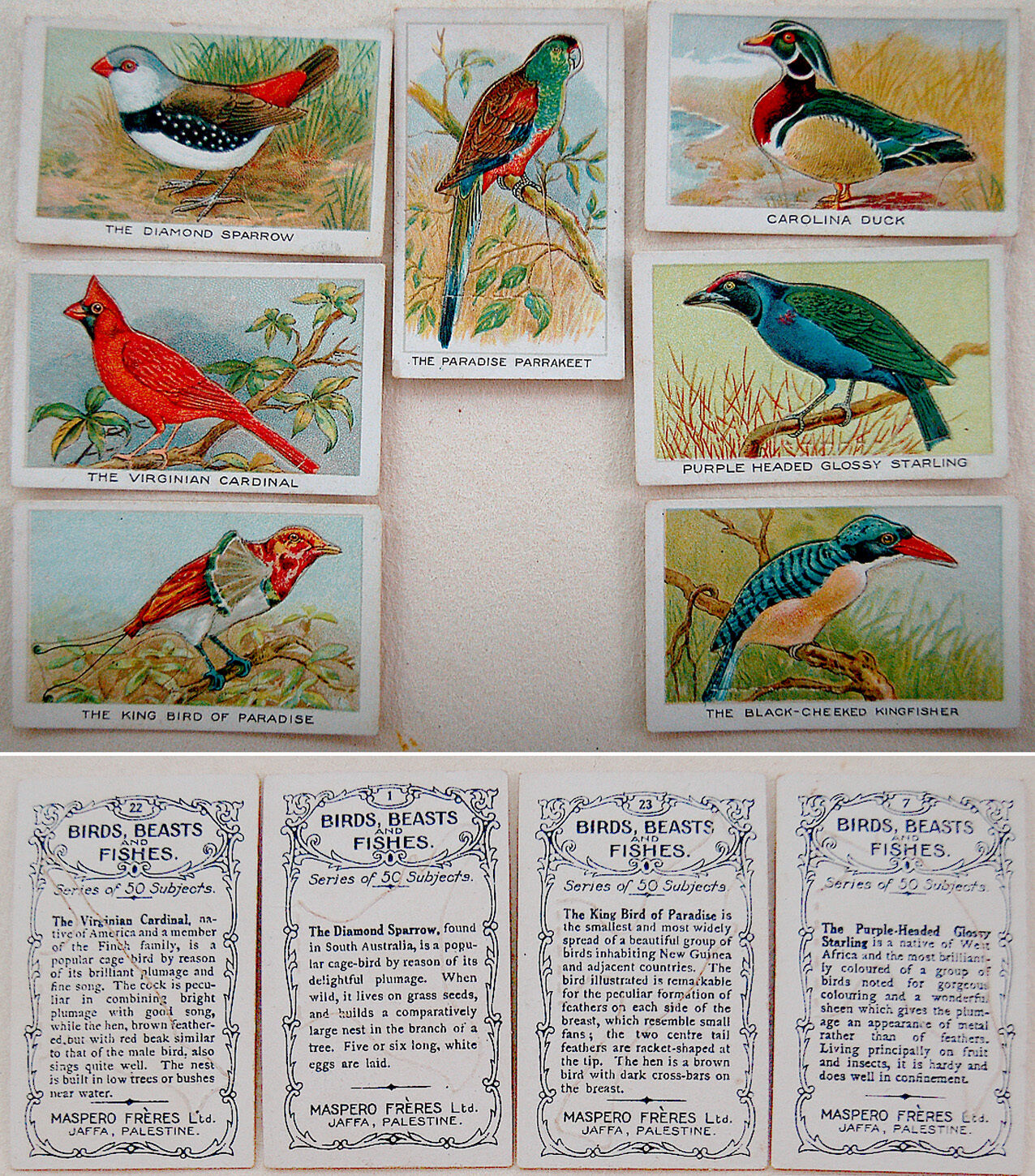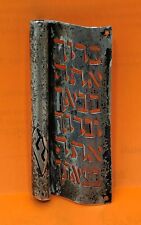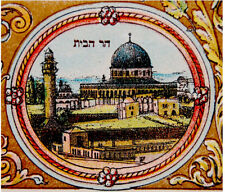1920 PALESTINE Israel 7 CIGARETTE POP-UP 3D CARDS Judaica BIRDS Ornithology RARE For Sale

When you click on links to various merchants on this site and make a purchase, this can result in this site earning a commission. Affiliate programs and affiliations include, but are not limited to, the eBay Partner Network.
1920 PALESTINE Israel 7 CIGARETTE POP-UP 3D CARDS Judaica BIRDS Ornithology RARE:
$125.00
DESCRIPTION : Up for sale is a MEGA RARE small collection of SEVEN POP UP CIGARETTE CARDS of BIRDS dated 1920\'s in ERETZ ISRAEL - PALESTINE .In the 1910\'s or 1920\'s , Before the MASPERO BROTHERS , The CIGARETTE MANUFACTORS from JAFFA Eretz Israel ( Then also refered to as Palestine ) , Have published their better known ALBUMS of CIGARETTE CARDS collections, They have started with a SERIE of POP UP advertising CIGARETTE CARDS . This SERIE of 50 CARDS of \"BIRDS , BEASTS and FISH\" is EXTREMELY RARE and hardly known among ISRAELIANA and PALESTINE TOBACCIANA collectors , Not to mention ornithologists and birds and ornithology fans and collectors. Never before in my over fourty years of ISRAELIANA collecting , Have I seen these genuinly RAREPop Up cigarette CARDS .The POP UP CARDS were printed as STONE LITHOGRAPH cut outs , With explanatory text on verso ( In English ) . When the cut out BIRD is folded , It POPS UP and can stand vertical , Leaning on the card as a display. Here for sale is an EXTREMELY RARE LOT of 7 birds : The DIAMOND SPARROW , The PARADISE PARAKEET , The CAROLINA DUCK , The VIRGINIAN CARDINAL , The PURPLE HEADED GLOSSY STARLING , The KING BIRD of PARADISE and the BLACK-CHIKED KINGFISHER . All 7 pop Up CARDS are STONE LITHOGRAPHIC printing. TheCARDS are written inENGLISH on verso with a short description of the BIRD and as HEADING below the picture . The MANUFACTURER is very clearly mentioned : \"MASPERO FRERES LTD. JAFFA . PALESTINE\" . I\'m offering these VERY RARE 7 cards for a reduced opening price of less than $30 apiece. Size around1.5 x 2.5\" .EXCELLENT condition. ( Pls look at scan for accurate AS IS images ) . Will be sent in a protective rigid sealed packaging.AUTHENTICITY : This is anORIGINALvintageca1910\'s up to the 1920\'s lot of SEVEN POP UP CIGARETTE CARDS, NOT a reproduction or a reprint ,It holds a life long GUARANTEE forits AUTHENTICITY and ORIGINALITY.PAYMENTS : Payment method accepted : Paypal .SHIPPMENT : SHIPP worldwide via registered airmail is $ 19 .Will be sent inside a protectivepackage . Handling around5-10 days after payment.MasperoFreres - Jaffa,Tel Aviv (1911-1914 then 1921 till 1956) – Al Hayat(1922),Astra, Aviv(1925), Emir(1923), Latif(1926), Matossian, Matossian 4,Matossian deluxe, Migdal, Narcissus, Noblesse (1935), Ora, Universal, Yishuv,Jasmin(1922), Royal, Parfuma, Golden West, Hollywood, Universal, Football,Tamar, Tavor (1925), Ya-Hi-Li-Li (1925), Virginia Tov, Emek, Al Ashraf (1922),Alma, Asfur, Bulbul, Bouton Rouge, Butterfly, Canon, Flying Camel, Hanoon,Margoub, Maspero (big packs & small Packs 1921), Melouki, Namal, Nur, Rodah6, Rodah, Rada, El shara, Samsoun, Soussa, Sevens, Extra.(in 1911 till1914 was a packing cigarette warehouse, under the Turkish occupation).Maspero ltd. Tel Aviv– (still manufacture after 1948 till 13th.March.1956 when went onvoluntary liquidation) - Emir, Maspero 18, Latif, Matossian Royal, Superfine,Universal, Jasmin, Nacshon, Leumi, Shofra, Zabra, Dalia, Nimrod. ***Thediamond firetail(Stagonopleura guttata) is a species ofestrildid finchthat is endemic toAustralia.Contents[hide]1 Taxonomy2 Description2.1 Song3 Behaviour3.1 Breeding3.2 Feeding4 Distribution and habitat4.1 Important bird areas5 Status and conservation6 Aviculture6.1 Mutations6.2 Nutrition7 References8 External linksTaxonomy[edit]Origin andphylogenyhas been obtained by Antonio Arnaiz-Villena et al.[2]Estrildinae may have originated in India and dispersed thereafter (towards Africa and Pacific Ocean habitats).Description[edit]The diamond firetail is a finch that has a fiery red bill, eyes, and rump. Just below the throat, it has a thick black band that extends horizontally until it reaches the lower part of the wings which are also black with white spots. There is also a black eye band that starts at the beak and ends right at the eye. The bird\'s tail is also black. The rest of the wings are a slightly tan, light brown colour. Its head and back is light grey and its belly and chin are white. The colour of the egg is also white. This bird is considered one of the smallest of the finches. Theparadise parrot(Psephotus pulcherrimus) was a colourful medium-sizedparrotnative to the grassy woodlands of theQueensland-New South Walesborder area of easternAustralia. Once moderately common within its fairly restricted range, the last live bird was seen in 1927. Extensive and sustained searches in the years since then have failed to produce any reliable evidence of it, and it is unknown if it is extinct or not.Paradise parrots lived in pairs or small family groups, making their nests in hollowed-outtermitemounds and similar places, often at or near ground level, and feeding, so far as is known, almost exclusively on grass seeds.The plumage was extraordinarily colorful, even by parrot standards, a mixture of turquoise, aqua, scarlet, black and brown, and the tail almost the same length as the body—something difficult to understand in a bird that, although a rapid, undulating flyer, spent almost all of its time on the ground.The reasons for the sudden decline of the paradise parrot remain speculative. Possibilities include overgrazing, land clearing, changed fire regimes, hunting by bird collectors, and predation byintroduced mammalslikecatsanddogs. It became rare towards the end of the 19th century and was thought extinct by 1915. A series of searches turned up a few more individuals over the next decade, but the last confirmed sighting was on 14 September 1927. Thewood duckorCarolina duck(Aix sponsa) is a species ofperching duckfound inNorth America. It is one of the most colorful North Americanwaterfowl.[2][3]Wood duck in flightWood duckLifting off to flyContents[hide]1 Description2 Behavior3 Distribution4 Conservation5 In popular culture6 Gallery7 References8 External linksDescription[edit]Close up of male headCallMENU0:00Several Wood Ducks callingProblems playing this file? Seemedia help.The wood duck is a medium-sizedperching duck. A typical adult is from 47 to 54cm (19 to 21in) in length with a wingspan of between 66 to 73cm (26 to 29in). This is about three-quarters of the length of an adultmallard. It shares its genus with the AsianMandarin duck(Aix galericulata).[2]The adult male has distinctive multicolored iridescent plumage and red eyes,with a distinctive white flare down the neck. The female, less colorful, has a white eye-ring and a whitish throat. Both adults have crested heads.The male\'s call is a rising whistle,jeeeeee; the females utter a drawn-out, rising squeal,do weep do weep, when flushed, and a sharpcr-r-ek, cr-e-ekfor an alarm call.[4]Behavior[edit]Their breeding habitat is woodedswamps, shallow lakes,marshesor ponds, and creeks in eastern North America, the west coast of theUnited Statesand westernMexico. They usually nest in cavities in trees close to water, although they will take advantage ofnesting boxesin wetland locations if available. Females line their nests with feathers and other soft materials, and the elevation provides some protection from predators.[5]Unlike most other ducks, the wood duck has sharp claws for perching in trees and can, in southern regions, produce two broods in a single season—the only North American duck that can do so.[4]Females typically lay between 7 and 15 white-tan eggs that incubate for an average of 30 days.[4]However, if nesting boxes are placed too close together, females may lay eggs in the nests of their neighbours, which may lead to nests which may contain as many as 30 eggs and unsuccessfulincubation, a behaviour known as \"nest dumping\".[6]After hatching, the ducklings jump down from the nest tree and make their way to water. The mother calls them to her, but does not help them in any way.[5]They prefer nesting over water so the young have a soft landing, but will nest up to 140m (460ft) away from the shoreline. The day after they hatch, the young climb to the nest entrance and jump to the ground. The ducklings can swim and find their own food by this time.\"These birds feed by dabbling or walking on land. They mainly eat berries, acorns, and seeds, but also insects, making themomnivores.[5]Distribution[edit]In Central Park, New York, USAThe birds are year-round residents in parts of its southern range, but the northern populations migrate south for the winter.[7][8]They overwinter in the southern United States near the Atlantic coast. 75% of the wood ducks in thePacific Flywayare non-migratory.[8]They are also popular, due to their attractive plumage, in waterfowl collections and as such are frequently recorded inGreat Britainas escapes—populations have become temporarily established inSurreyin the past but are not considered to be self-sustaining in the fashion of the closely relatedMandarin duck.[citation needed]Given its native distribution the species is also a potential natural vagrant to Western Europe and there have been records in areas such asCornwall,Scotlandand theIsles of Scillywhich some observers consider may relate to wild birds; however, given the wood duck\'s popularity in captivity it would be extremely difficult to prove their provenance one way or another.[citation needed]There is a small feral population inDublin.[citation needed]Conservation[edit]The population of the wood duck was in serious decline in the late 19th century as a result of severe habitat loss and market hunting both for meat and plumage for the ladies\' hat market in Europe. By the beginning of the 20th century, wood ducks had virtually disappeared from much of their former range. In response to the Migratory Bird Treaty established in 1916 and enactment of the U.S.Migratory Bird Treaty Act of 1918, wood duck populations began to recover slowly. By ending unregulated hunting and taking measures to protect remaining habitat, wood duck populations began to rebound in the 1920s. The development of the artificial nesting box in the 1930s gave an additional boost to wood duck production.[9]Landowners as well as park and refuge managers can encourage wood ducks by building wood duck nest boxes near lakes, ponds, and streams.Fulda, Minnesota has adopted the wood duck as an unofficial mascot, and a large number of nest boxes can be found in the area.[citation needed]ExpandingNorth American beaverpopulations throughout the wood duck\'s range have also helped the population rebound as beavers create an ideal forested wetland habitat for wood ducks.[8]The population of the wood duck has increased a great deal in the last several years. The increase has been due to the work of many people constructing wood duck boxes and conserving vital habitat for the wood ducks to breed. During the open waterfowl season, U.S. hunters have only been allowed to take two wood ducks per day in theAtlanticandMississippi Flyways. However, for the 2008–2009 season, the limit was raised to three. The wood duck limit remains at two in theCentral Flywayand at seven in thePacific Flyway. It is the second most commonly hunted duck in North America, after the mallard.[2]In popular culture[edit]In 2013, theRoyal Canadian Mintcreated two coins to commemorate the wood duck. The two coins are each part of a three coin set to help promoteDucks UnlimitedCanada as well as celebrate its 75th anniversary.[10]Northern CardinalVirginia State Birdpairnortherncardinals.jpgNorthern cardinal pair; photo byIlona L on Flickr(noncommercial use permitted with attribution / share alike).Official State Bird of VirginiaVirginia designated the northern cardinal (Cardinalis cardinalis) as official state bird in 1950. One of America\'s favorite backyard birds; the northern cardinal is the official bird symbol of seven states (Illinois, Indiana, Kentucky, North Carolina, Ohio, Virginia, and West Virginia).All State BirdsNorthern Cardinal FactsNorthern cardinals are distinctive in appearance and song - they\'re known for their \"cheer cheer cheer,\" \"whit-chew whit-chew\" and \"purty purty purty\" whistles. Both the male and female sing (few female songbird species sing in North America).Male cardinals are a brilliant scarlet red, females a buffy-brown with reddish wings - both have a jet-black mask, pronounced crest, and heavy bill. The cardinal sings nearly year-round, and the male aggressively defends his 4-acre territory (male cardinals have been seen attacking small red objects mistaken as other males).Northern cardinals breed 2-3 times each season. The female builds the nest and tends the hatchlings for about 10 days while the male brings food. The male then takes over the care of this first brood while the female moves on to a new nest and lays a second clutch of eggs.Thepurple-headed starling(Hylopsar purpureiceps), also known as thepurple-headed glossy-starling, is a species ofstarlingin the familySturnidae.Distribution and habitat[edit]It is found inAngola,Benin,Cameroon,Central African Republic,Republic of the Congo,Democratic Republic of the Congo,Ivory Coast,Equatorial Guinea,Gabon,Guinea,Nigeria, andUganda.Thepurple starling(Lamprotornis purpureus), also known as thepurple glossy starling, is a member of thestarlingfamily ofbirds.Contents[hide]1 Distribution and habitat2 Description3 Behaviour3.1 Breeding3.2 Feeding4 ReferencesDistribution and habitat[edit]It is a resident breeder in tropicalAfricafromSenegaland northZaireeast toSudanand westKenya. This commonpasserineis typically found in openwoodlandand cultivation.Description[edit]The adults of these stocky 22–23cm long birds have a metallic purple head and body, and glossy green wings. They have a short tail and a yellow eye. The sexes are similar, but juveniles are much duller, with grey underparts and a brown iris.Behaviour[edit]This is a gregarious and noisy bird, with typical starling squeaks and chattering.Breeding[edit]The purple starling builds anestin a hole. The normal clutch is twoeggs.Feeding[edit]Like most starlings, the purple starling isomnivorous, eatingfruitandinsects.Theking bird-of-paradise(Cicinnurus regius) is apasserinebird of theParadisaeidae(Bird-of-paradise) family.The king bird-of-paradise is distributed throughout lowland forests ofNew Guineaand nearby islands. The diet consists mainly of fruits andarthropods.An extraordinarycourtship displayis performed by the male with a series of tail swinging, fluffing of the white abdominal feathers that makes the bird look like a cottonball, and acrobatic movements of their elongated tail wires.Widespread and a common species throughout their large habitat range, the king bird-of-paradise is evaluated as Least Concern on theIUCN Red Listof Threatened Species. It is listed on Appendix II ofCITES.The first captive breeding of this species was by Dr. Sten Bergman of Sweden in 1958. He was awarded a commemorative medal by the Foreign Bird League to mark this achievement.Contents[hide]1 Description2 Subspecies3 References4 External linksDescription[edit]This so-called \"living gem\"[2]is the smallest and most vividly colored among birds-of-paradise. The king bird-of-paradise is small, approximately 16cm long. The male is crimson and white with bright blue feet and green-tipped fan-like plumes on his shoulder. The two elongated tail wires are decorated with emerald green disk feathers on its tip. The unadorned female is a brown bird with barring below.Subspecies[edit]Cicinnurus regius coccineifronsCicinnurus regius cryptorhynchusCicinnurus regius gymnorhynchusCicinnurus regius regiusCicinnurus regius rexCicinnurus regius similisTheblack-capped kingfisher(Halcyon pileata) is atree kingfisherwhich is widely distributed in tropicalAsiafrom India east to China,Koreaand Southeast Asia. This most northerly of the Halcyonidae is resident over much of its range, but northern populations aremigratoryand they wintering south of their range toSri Lanka,Thailand,BorneoandJava. It is distinctive in having a black cap that contrasts with the whitish throat, purple blue wings and the coral red bill. The species is mainly found in coastal andmangrovehabitats but can sometimes be found far inland.Contents[hide]1 Description2 Distribution and habitat3 In culture4 ReferencesDescription[edit]Adult along theZuari RiverThis kingfisher is about 28 centimetres (11in) long. The adult has a purple-blue wings and back, black head and shoulders, white neck collar and throat, and rufous underparts. The large bill and legs are bright red. In flight, large white patches or \"mirrors\" at the base of the primaries are visible on the blue and black wings. Sexes are similar, but juveniles are a duller version of the adult and show streaks on the throat.[2]The call of this kingfisher is a cacklingki-ki-ki-ki-ki.Usually seen on coastal waters and especially in mangroves, it is easily disturbed, but perches conspicuously and dives to catch fish but also feeds on large insects. The flight of the black-capped kingfisher is rapid and direct, the short rounded wings whirring.The breeding season is in summer. The nest is a tunnel in an earth bank. A single clutch of 4-5 round white eggs is typical.[2]A subspeciespalawanensishas been described but the species is considered to be monotypic with no clear plumage differences across their range.[3]Distribution and habitat[edit]The species is found mainly near the coast in mangrove forests and along estuaries and rivers. The distribution ranges from India (including the Andaman and Nicobar Islands where they occur even on remote islands like Narcondam[4]), Sri Lanka, Kansu, Shansi, Korea, Malay Peninsula, Thailand, Burma,[5]Ryu kyu Islands, Hainan, Philippines (Palawan, Balabac, Basilan, Tawi Tawi), Borneo, Sumatra east to Sulawesi where it occurs only in winter.[3]Vagrants in winter have been recorded in Pakistan[6]while movements related to rainfall may lead to their being found far inland and away from their usual distribution.[7][8][9][10][11]In culture[edit]Like many other kingfishers, this species was much sought for the blue feathers for their use in the millinery trade. Feathers were used in making fans in China.[11]In Hong Kong, their feathers were cut and glued over ornaments used by women.[12] 3998/128

Related Items:
Mezuzah Box Circa 1920 Palestine Israel
$125.00
1920 PALESTINE Israel 7 CIGARETTE POP-UP 3D CARDS Judaica BIRDS Ornithology RARE
$125.00
1920 Palestine JERUSALEM LITHOGRAPH POSTER Wailing Wall TEMPLE MOUNT Judaica
$98.00



